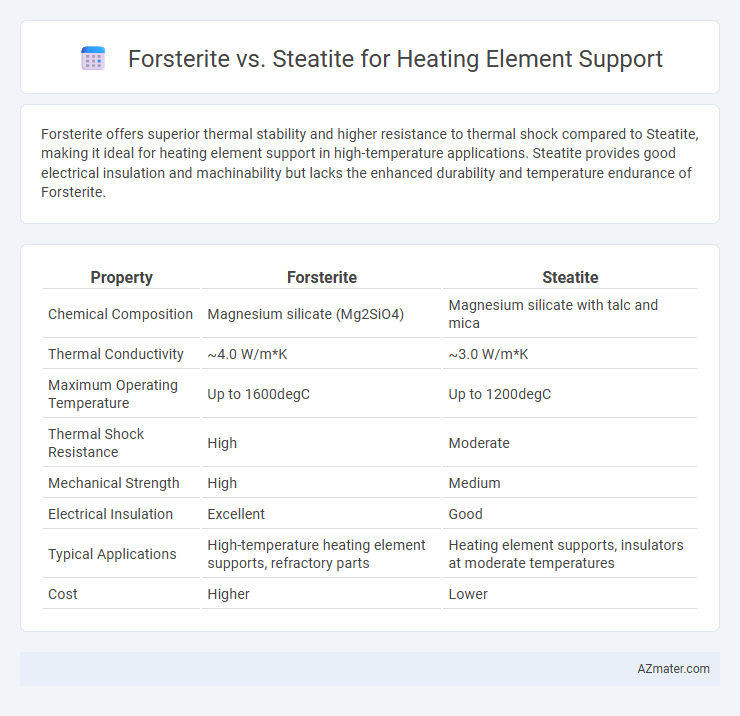Forsterite offers superior thermal stability and higher resistance to thermal shock compared to Steatite, making it ideal for heating element support in high-temperature applications. Steatite provides good electrical insulation and machinability but lacks the enhanced durability and temperature endurance of Forsterite.
Table of Comparison
| Property | Forsterite | Steatite |
|---|---|---|
| Chemical Composition | Magnesium silicate (Mg2SiO4) | Magnesium silicate with talc and mica |
| Thermal Conductivity | ~4.0 W/m*K | ~3.0 W/m*K |
| Maximum Operating Temperature | Up to 1600degC | Up to 1200degC |
| Thermal Shock Resistance | High | Moderate |
| Mechanical Strength | High | Medium |
| Electrical Insulation | Excellent | Good |
| Typical Applications | High-temperature heating element supports, refractory parts | Heating element supports, insulators at moderate temperatures |
| Cost | Higher | Lower |
Introduction to Forsterite and Steatite
Forsterite and Steatite are key materials used for heating element supports in high-temperature applications, prized for their excellent thermal and electrical insulating properties. Forsterite, a magnesium silicate mineral (Mg2SiO4), offers superior mechanical strength and resistance to thermal shock, making it ideal for environments exceeding 1200degC. Steatite, composed primarily of magnesium silicate with lower density and higher machinability, performs well at moderate temperatures up to 1100degC but generally exhibits lower mechanical durability compared to Forsterite.
Material Composition and Structure
Forsterite, composed primarily of magnesium silicate (Mg2SiO4), features a crystalline structure that provides high-temperature stability and excellent thermal conductivity, making it ideal for heating element support in high-temperature applications. Steatite, primarily made of magnesium silicate with a significant amount of talc (hydrous magnesium silicate), offers superior electrical insulation and mechanical strength but lower thermal conductivity compared to Forsterite. The difference in crystalline microstructure--Forsterite's dense orthorhombic crystals versus Steatite's talc-based laminar formation--directly impacts their thermal and electric properties, influencing their suitability in heating element support systems.
Thermal Conductivity Comparison
Forsterite offers superior thermal conductivity ranging from 5 to 6 W/m*K, making it highly efficient for heat dissipation in heating element supports. Steatite, with a lower thermal conductivity around 3 to 4 W/m*K, provides better insulation but less effective heat transfer. Choosing Forsterite enhances heating element performance by reducing thermal resistance, whereas Steatite prioritizes electrical insulation with moderate thermal management.
Electrical Insulation Properties
Forsterite exhibits superior electrical insulation properties compared to Steatite, with a dielectric strength exceeding 15 kV/mm, making it ideal for high-temperature heating element support applications. Steatite, while offering good thermal resistance, typically has a lower dielectric strength around 8-10 kV/mm, which may limit its effectiveness in environments with high electrical stress. The high purity and crystalline structure of Forsterite contribute to its enhanced insulation performance and greater stability under thermal cycling conditions.
Mechanical Strength and Durability
Forsterite offers superior mechanical strength and thermal shock resistance compared to steatite, making it more durable for heating element support in high-temperature applications. Steatite, while cheaper and easier to machine, has lower fracture toughness and is more prone to cracking under mechanical stress. Forsterite's enhanced durability ensures longer service life and reliability in industrial heating environments.
Temperature Resistance Capabilities
Forsterite offers superior temperature resistance capabilities, withstanding continuous exposure up to approximately 1400degC, making it ideal for high-temperature heating element support applications. Steatite supports lower temperature ranges, typically up to 1000degC, due to its magnesium silicate composition which limits its thermal stability under extreme heat. The enhanced thermal durability of forsterite ensures prolonged performance and structural integrity in demanding industrial heating environments.
Application Suitability in Heating Elements
Forsterite offers superior mechanical strength and thermal stability, making it highly suitable for supporting heating elements in high-temperature applications up to 1400degC. Steatite provides excellent electrical insulation and moderate thermal resistance, ideal for lower temperature environments typically below 1000degC. Choosing Forsterite ensures enhanced durability and performance in demanding heating element supports, while Steatite is preferred for cost-effective insulation in less extreme thermal conditions.
Cost and Availability Analysis
Forsterite offers moderate cost and good availability as a heating element support material, primarily due to its natural abundance and widespread industrial use. Steatite, although generally less expensive than Forsterite, may have limited availability depending on geographic location and specific grade requirements, impacting overall supply stability. Cost analysis favors Steatite for budget-sensitive applications, while Forsterite's consistent supply and performance justify its higher price in critical heating systems.
Pros and Cons of Forsterite vs Steatite
Forsterite offers superior thermal shock resistance and higher mechanical strength compared to Steatite, making it ideal for high-temperature heating element supports in industrial applications. Steatite provides excellent electrical insulation and is more cost-effective, but it has lower thermal stability and is more prone to cracking under rapid temperature changes. Choosing Forsterite supports results in longer durability and enhanced performance in demanding environments, whereas Steatite is preferred for budget-sensitive projects with moderate temperature requirements.
Conclusion: Best Choice for Heating Element Support
Forsterite is the best choice for heating element support due to its superior high-temperature resistance, excellent thermal stability, and mechanical strength compared to steatite. Steatite offers good electrical insulation but falls short in durability and thermal shock resistance under extreme conditions. Selecting forsterite ensures enhanced longevity and performance in heating element applications.

Infographic: Forsterite vs Steatite for Heating Element Support
 azmater.com
azmater.com